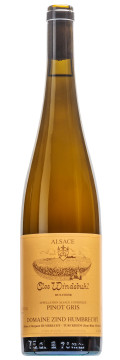
Technical presentation
| Bottling : | March 2015 |
|---|---|
| Acquired alcohol : | 14.5° |
| Residual sugar : | 10.0 g/l |
| Total acidity : | 4. g/l H2SO4 (6.4 g/l Acide Tartrique) |
| pH : | 3.4 |
| Yield : | 20 hl/ha |
| Optimum tasting : | 2017-2033+ |
| Average age of vines : | 44 years |
| Grape variety : | Pinot Gris |
| Terroir : | Clos Windsbuhl |
| Sweetness index : | 2 |
| Soil : | Muschelkalk calcareous, South/South East facing |
Description of the wine Pinot Gris Clos Windsbuhl 2013
What we call the ‘old vines’ in the Clos Windsbuhl are the vines which were planted in 60s and 70s, old enough to be planted with good massal selections and higher vine density. The Clos Windsbuhl has the capacity to retain acidity, slow down the ripening process for more flavours and bring the vigour down, mostly because of its higher location and poor rocky limestone soil. It is hard for a vineyard to express clearly its difference, but there is no ambiguity here. In 2013, we didn’t aim for too much noble rot development (the climate wasn’t helping at the end of harvest anyway) so it was possible for the yeasts, after a full yearlong fermentation, to achieve a drier wine than usual.

Tasting notes
03/2015 : Bright yellow colour, giving away the ripeness of the grapes, but perhaps wrongly influence on the style of the wine. The nose also shows rich, intense honey aromas, herbal notes and fruity flavours. This isn’t a shy nose! The palate comes then as a total surprise. Where the taster expects roundness and VT like sweetness, there are minerals, fierce acidity, chalky aromatics and a characterful palate. Long finish, there is obviously some discreet sweetness there, but well hidden in this big wine.

The Clos Windsbuhl of Hunawihr
The altitude of the vineyard coupled with Hunawihr’s tardy climate means that the Clos Windsbuhl is often one of the last of our vineyards to be harvested. This explains the aromatic quality of the Clos’ wines and the consistent balance of acidity, a guarantee of good ageing. Although often harvested late, the Windsbuhl grapes are only rarely botryitized, doubtless due to the altitude of the vineyard, but nevertheless often reach high levels of maturity.